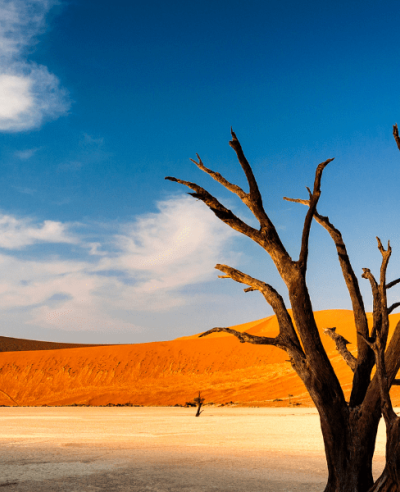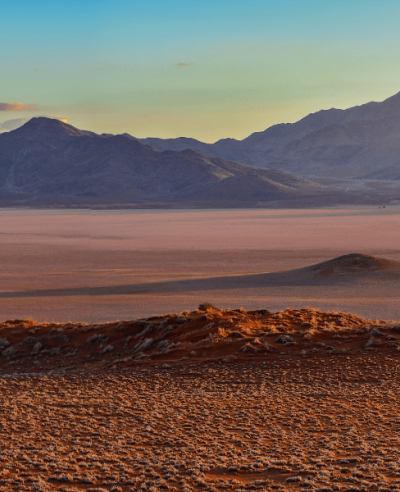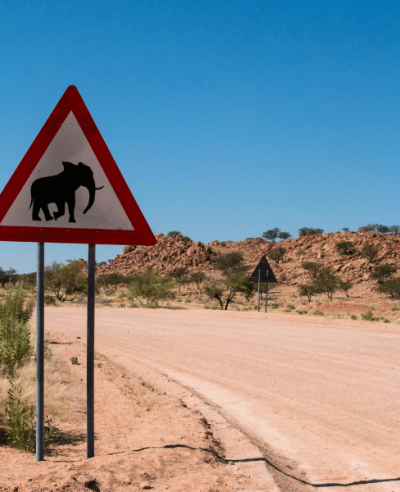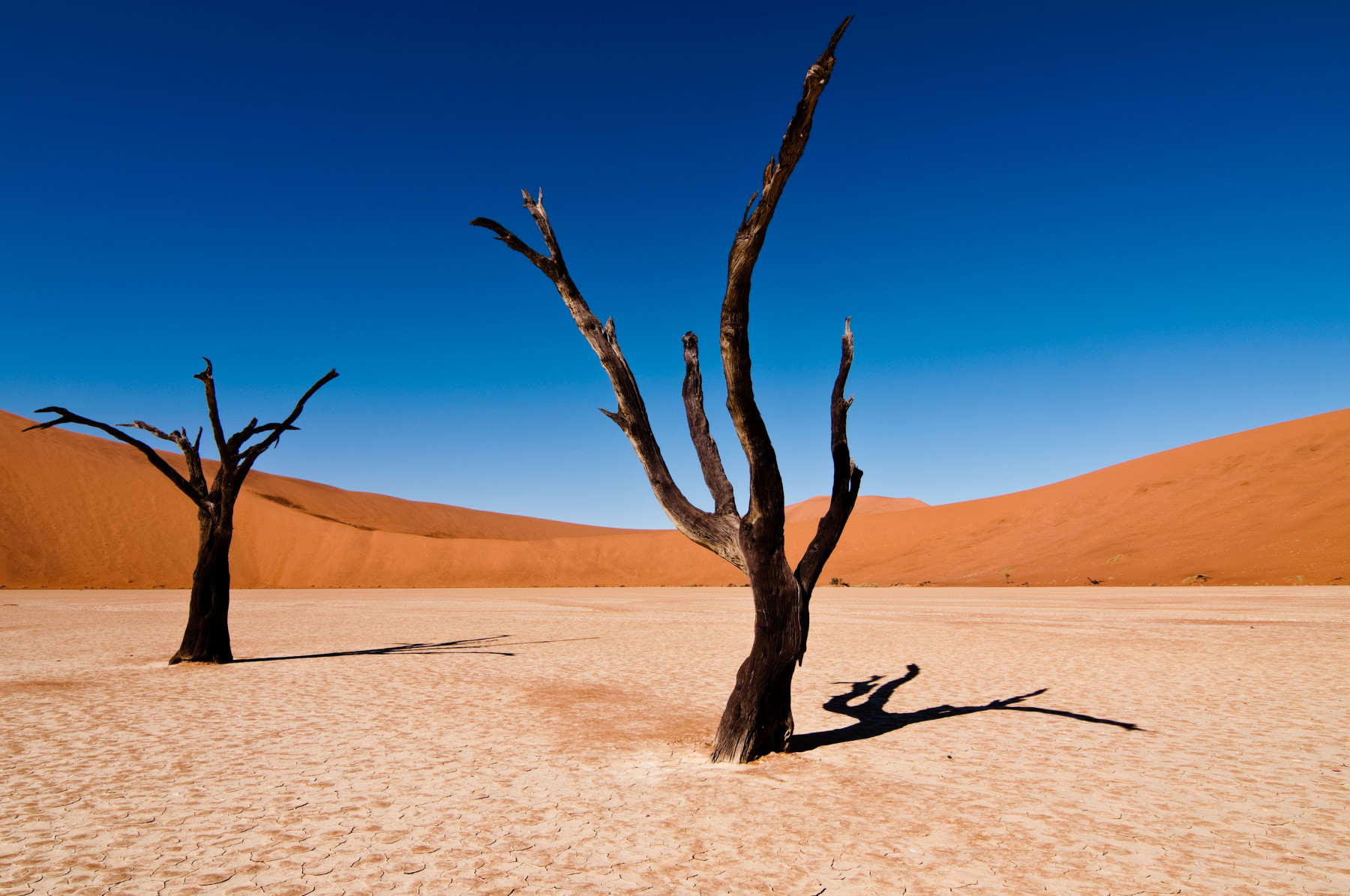
Namibia
Namibia
Namibia, the country of golden deserts and blue skies. Whoever thought that Namibia only has sand to offer is so wrong. Namibia has some of the most fascinating tribes. It's also home to the highest concentration of free-roaming cheetahs on the African continent and has the oldest and second-largest canyon in the world.
This tour is a great introduction to Namibia and you will get to spend time among some of the greatest highlights of the country, including the Sossusvlei, Swakopmund, and Etosha National Park.
You could spend a lifetime exploring Namibia. Here we've assembled the highlights in this 14-day Namibia & Northern Cape tour – a journey of fascinating discovery in Southern Africa ending in beautiful Cape Town.
Follow the footprints of Dr. Livingstone, you will start this tour in Livingstone, Zambia, and head through some amazing wildlife reserves and concessions in Botswana towards Namibia where you witness some amazing nature. From the bright orange dunes in Sossusvlei to the dunes ending in the ocean in Swakopmund, it’s a truly magical combination to visit these 3 countries. This tour is a self-drive camping tour with an upgrade to lodges during some nights.
Discover Namibia
A trip through Namibia is a wonderful experience. Namibia used to be a German colony and that is still noticeable in Namibia today. There are many buildings and monuments that are reminiscent of the German colonial era.
Enjoy amazing views in Kalahari and the Fish River Canyon. Discover the oldest desert in the world, the Namib desert with its deserted desert landscape and beautiful red, petrified dunes. Explore the Sossusvlei, the white clay plain surrounded by the highest dunes in the world gives a wonderful contrast. Go on a safari in Etosha National Park, which covers an area of no less than 22,270 square kilometers. Learn about the special way of living and dressing during a meeting with a Himba tribe. A very special country with lots of natural beauty, culture, and wild animals.
A tour through the Namib desert, plateau, and Kalahari desert.
The Namib desert lies on the coast. It is a narrow coastal strip with a harsh and very dry climate. There is virtually no rainfall in this area. It is one of the driest areas on earth. In the interior, running from north to south, you will find an elongated plateau with peaks of over two thousand meters. The highlights are the Auasberge and the Brandberg. This area has the most regular rainfall and is, therefore, the most densely populated.
In the east and southeast, you will find the Kalahari desert. If the moist air from the trade winds rises above land, precipitation falls out. If the air is above the Kalahari, it has already lost a large part of its moisture, but the rainfall is sufficient to allow steppe vegetation with hard, spiky flora.
Namibia is a beautiful country and ideal for a tour. Take the town of Swakopmund, for example. It has a distinctly German character due to the fact that Namibia was once a German colony. A lot of German is also spoken. It is a popular destination for European tourists. Sand from the neighboring Namib desert regularly covers the town. The Sossusvlei lies in this desert. It is an area with red sand dunes that can be up to 300 meters high and that move slowly due to the wind. You can enjoy a beautiful sunrise.
Another unmissable part of Namibia is the Etosha National Park. It is one of the largest nature reserves in southern Africa. It was founded in 1907, after the war between the Germans and the Hereros. Etosha consists of a large part of a huge salt pan that is surrounded by dry bushveld. You come across large amounts of game such as elephants, zebras, and lions. There are also artificially constructed water drinking places that help the wildlife population survive in the dry season.
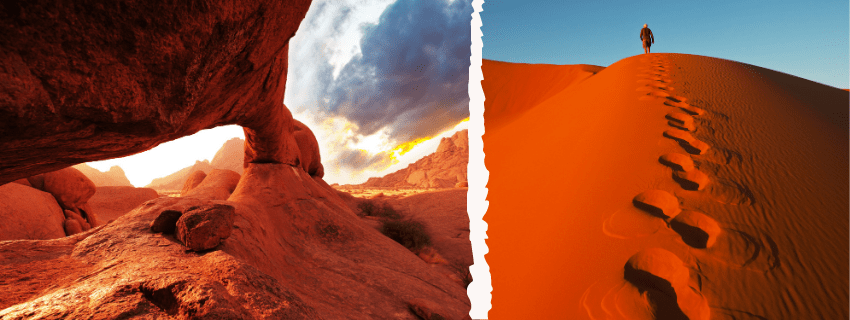
Practical information Namibia
Itineraries While we intend to adhere to the route described in your contract, there is a certain amount of flexibility built into the itinerary and on occasion, it may be necessary, or desirable to make alterations. The contract is a general guide to the tour, region and proposed itinerary any mention of specific wildlife is by no means a guarantee that they will be encountered, as we can never guarantee what mother nature has to offer us. Additionally, any travel times listed are approximations only and subject to vary due to local circumstances.
Accommodation If a hotel is unexpectedly fully booked, we will always contact you before booking an alternative. We will always offer alternatives to the same level and value for money. Kindly note that water scares in many parts of the world, so we always recommend taking short showers and reuse towels if possible.
Emergency Contact Should you need to contact Your Travel Nation during a situation of dire need, it is best to first call our local partner. If you do not receive an immediate answer for any reason, please leave a detailed message and contact information, so they may return your call and assist you as soon as possible. If you are unable for any reason to contact our local office, we have an emergency line, which will connect you directly with our office.
+1 757 656 3391
Luggage You will be on the move a lot, so our advice is to pack as lightly as possible. Your baggage should be restricted to one medium-sized rolling bag, duffle bag or backpack, maximum 15kg, plus a daypack. Luggage limits on airlines are strictly enforced and space on vehicles is limited.
What to Pack? – Packing list
Documents:
• Flight info (Printouts of e-tickets may be required at the immigration)
• Insurance info (With photocopies)
• Passport (With photocopies)
• Required visas or vaccination certificates (With photocopies)
• Copy of your contract
Essentials:
• Any medication you might need: This should include medication for possible common situations like headaches or diarrhoea;
• Sunblock, sunglasses, hat, and lip balm.
• Your electronic devices and chargers.
For camera and lenses; we recommend bringing a wide lens (about 17-55mm) for those scenery pictures, and a telephoto lens (in the 200-400mm range) to catch animals at a distance; Renting a camera is not possible. Please ensure your camera equipment is appropriate for different weather conditions;
• Clothes: Comfortable and casual clothing, with khaki, beige or green colours. You should pack T-shirts, shirts with long sleeves, jeans, a sweater and a jacket (for the cold mornings), swimwear (if the accommodation you selected has a pool or if you do a beach extension), and comfortable hiking shoes;
• Insect repellent;
• Refill water bottle;
• Adaptor for D and M Type Plugs.
Laundry Hand washing of clothes can be done at most of the hotels where you will stay. We recommend you bring a non-polluting/biodegradable soap, as well as a roll of simple string to act as a drying line for your clothes. If you arrive in the late afternoon, or if there is poor weather, it may not be possible for your clothes to completely dry. Your hotels may also have a laundry service available at an additional fee.
Visa requirements As a tourist, a visa is obtained upon arrival. It is valid for a maximum stay of 90 days. You have to make sure that your passport is valid for another 6 months from the day of departure from Namibia. As well you will need proof of travelling out of Namibia.
Insurance A travel insurance is highly recommended when travelling. When selecting a travel insurance policy please bear in mind that we highly recommend good medical coverage and repatriation and emergency rescue. We strongly recommend that the policy also covers personal liability, cancellation, curtailment and loss of luggage and personal effects. We don’t issue any insurances; however, we recommend using www.worldnomads.com
Health We recommend you contact your family physician, or your local travel clinic for the most up-to-date health information at least three months before departure or in case of a last-minute tour, as soon as you confirm your travels. Travellers are also advised to carry a basic first-aid kit and hand sanitisers/antibacterial wipes on their travels. Medical facilities are basic throughout these countries. For your own safety, we strongly recommend that you advise your local guide of any medical condition that may affect you while travelling. Your local guide will be able to inform you of local health advisories (e.g. drinking water quality). Please ensure you have all the inoculations recommended by your doctor.
Allergies and dietary restrictions This is something we take very seriously. Upon booking with us, we will send you a form in which you will be able to indicate any dietary preference or restriction or any specific request you might have. We will then provide that information in advance to all the hotels.
Safety and Security Many national governments provide a regularly updated advice service on safety issues involved with international travel. We recommend that you check your government's advice for their latest travel information before departure. We strongly recommend the use of a neck wallet or money belt while travelling, for the safe keeping of your passport, air tickets, bank cards, cash and other valuable items. Leave your valuable jewellery at home - you won't need it while travelling. Many of the hotels we use have safety deposit boxes which is the most secure way of storing your valuables. A lock is recommended for securing your luggage. Illegal drugs will not be tolerated on any trips. Possessing or using drugs not only contravenes the laws of the land but also puts the rest of your group at risk. Smoking marijuana and opium is a part of local culture in some parts of the world but is not acceptable for our travellers. Our philosophy of travel is one of respect towards everyone we encounter and in particular the local people who make the world the special place it is. The exploitation of prostitutes is completely contrary to this philosophy. Our local guides have the right to expel any member of the group if drugs are found in their possession or if they use prostitutes.
Photography and drone laws Please refrain from taking photos of police stations, airports, bus stations, immigration or border crossings, army barracks and personnel, or any government building. It is against the law and will result in the minimum of your film and camera being confiscated. The use of drones in national parks in Southern Africa is prohibited.
Electricity In Namibia, the power plugs and sockets are of type D and M. The standard voltage is 220 V and the standard frequency is 50 Hz.
Religion Religion in Namibia is dominated by Christianity, with more than 90 per cent of Namibian citizens identifying themselves as Christian.
Climate Mostly, Namibia has a subtropical desert climate characterized by great differences in day and nighttime temperatures, low rainfall and overall low humidity. Namibia experiences winter and summer at opposite times as Europe and North America and they correspond to the Dry and Wet seasons.
Best time to visit The best time to visit Namibia is in the Dry season from June to October, although it can be visited throughout the year. Wildlife viewing in all parks, but especially in Etosha, is best in the Dry season. The climate is generally dry and pleasant. Between December and March, some days will be humid and rain may follow, often in localized, afternoon thunderstorms. In the Wet season, animals move away from the waterholes and scatter around the park.
Plastic bags Plastic bags are not banned from entering Namibia. However, plastics bags are banned from entering national parks. For this reason, we recommend only bringing Ziplock bags that are specifically used to carry toiletries will be permitted as they are expected to remain in the permanent possession of visitors and are not expected to be disposed of in the country or national parks.
Money and currency In Namibia, the local currency is the Namibian Dollar, but you can also pay with the South African Rand. You can bring USD, Euros or Pounds and exchange them at any bank in Windhoek. American Dollars that are series 2006 or earlier are not accepted and very difficult to change in Southern and Eastern Africa, because of past forgeries. Every traveller is different and therefore spending money requirements will vary. Some travellers may drink more than others while other travellers like to purchase more souvenirs than most. Please consider your own spending habits when it comes to allowing for drinks, shopping and tipping. We always recommend carrying enough cash if you would like to pay for something in a remote place and the credit card machine cannot connect to any network. Please keep in mind that credit- or debit card payments may be subject to an extra charge, varying from 3.5% - 5%.
Dress code During the safari, we recommend you wear comfortable clothes in natural colours like beige, khaki, and green. Always bring a hat while on safari as it’s easy to catch a sunburn. During safaris, comfortable shoes like sports shoes are recommended. In the case of hiking, comfortable hiking shoes are recommended. In cities and villages, we advise you to wear modest clothing as Namibia is a conservative country.
Blog posts about Namibia
Why book with us?
Great value for money
With our partners being on the ground and getting the best prices for you, we assure you that our prices are unbeatable.
Travel with Care
Not only do we care about our guests and their experience, the world itself is one of our main concerns.
Customised itineraries
Everyone is different and therefore no request is too crazy. Customise your trip down to the finest detail.
Need any help booking? Call us anytime: +1 (757)-656-3391
